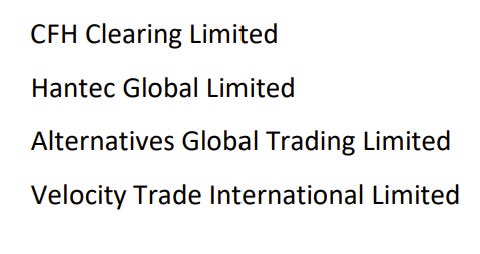Two things seemed to happen after ESMA introduced a wave of regulations on CFDs in August 2018.
One was that many firms realised they could circumvent the rules by only going for professional clients and/or redesignating existing clients as professional. This didn’t work because…
- Most existing clients couldn’t meet the requirements needed to be classified as professional.
- Most new clients couldn’t either.
The other thing was that many brokers suddenly decided to start offering ‘institutional’ services or, in some cases, a ‘prime-of-prime’ offering.
A prime broker can provide things like access to margin trading on physical assets, margin trading on synthetics, clearing, and other custodial services.
Prime-of-prime, at least to me, seems like it should be a company that provides prime brokerage-esque services to companies that can’t, probably because they don’t have the balance sheet to do it, gain access to mainstream prime brokerage services.
The added caveat is those providing a prime-of-prime service should have that access. So if you are executing trades with a prime-of-prime, you’d expect that they have real prime brokerage relationships in place.
It’s pretty clear that this is simply not the case for some companies purporting to offer prime-of-prime services. To be fair, this isn’t really new and some people have been pointing it out for a few years. And yet it still amazes me that there are brokers out there offering a ‘prime’ service when they are almost certainly just making a market on any order flow that gets sent their way.
One company that seems to have been growing, or at least upping its marketing spend a lot, over the past couple of years has some neat linguistic tricks to try and obfuscate the fact that this is very likely what they’re doing.
But all you have to do is dig through their order execution report to see that one of their ‘liquidity providers’ is also a major shareholder in the business. It’s not clear who their other liquidity providers are, so it may be the case that they’re making a market on all or most of the order flow which gets sent their way.
Another tactic is to call yourself a ‘prime-of-prime’ but then execute trades with….another prime-of-prime. Alternatively you can execute with a retail broker that runs a b-book.

For example, one company offering prime-of-prime services currently lists the companies in the picture above as its execution venues. Fair play to them for being transparent but those are all either brokers making a book or prime-of-primes.
This Russian doll-like process can get even more ridiculous as sometimes you’ll have a company offering prime-of-prime services connecting to another company offering prime-of-prime, who in turn is executing with a prime-of-prime.
So in effect the company is a prime-of-prime-of-prime-of-prime. And if anyone had used the original company’s services, they could even start offering their own prime services and be a prime-of-prime-of-prime-of-prime-of-prime. Got that?
Block trades and bad execution
I was thinking about all of this recently because of some news that came out about Morgan Stanley’s block trading business.
The investment bank is being investigated by regulators because it may have been leaking information to hedge funds about block sales that was then used to take a position in the market.
In short, Morgan Stanley would call fund managers and see if they were interested in participating in a block trade. The hedge fund would then short the relevant shares, knowing the sale would push the price down and that they could cover their short from it.
Reading the story made me wonder if prime-of-primes could end up doing something similar to their own liquidity providers.
A few prime-of-primes appear to be connected to some of the same banks and non-bank market makers. You might expect that they’d get the same pricing as a result. But maybe not?
If you’re making a market on any asset then at some point you’ll end up being lopsided and have risk on your books.
For instance, if you make a market on a CFD on Tesla shares then you might at some point be in a position where…
- You are short £500m
- You are long £400m
The result is you have £100m of risk on your book. You could go to the underlying market and hedge that away. Alternatively you could improve your spread on the long side, making the price more competitive. Hopefully this will attract more buyers that help you offload your risk.
The problem here is that you can end up in something like a miniature short-squeeze. Revealing the better price is a bit like the Morgan Stanley bankers calling up hedge funds and saying they’ve got a big block of shares to sell – you’re signalling to the market that you have a position you want to unload.
Smart market participants may figure this out and then do the opposite of what you want. They know you’re going to move the market in their favour and can put pressure on you to make it happen.
Now imagine that you’re doing this regularly and feeding your prices to two prime-of-primes.
In this instance…
- The first prime-of-prime executes trades that help you offload your risk
- The second prime-of-prime executes trades that increase your risk
If this happens all the time then at a certain point you might start to get very annoyed with the second prime-of-prime. In fact, you might think, “every time I show this idiot my better pricing, I get squeezed out of my position. From now on, this prime-of-prime doesn’t get my better prices.”
Assuming that did happen, then you could have two prime-of-primes using one or more of the same prime brokers but one would be getting better pricing than the other.
Could this happen? It seems plausible. Does it happen? I have no idea. Was it fun to theorise that it might be happening? Reasonably.
Have a good week everybody.
Stuff that happened:





